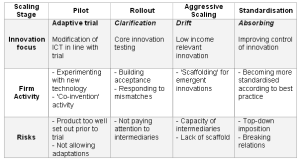19 Jan 2014
In developing countries, there is growing interest in adapting new technologies to allow them to reach low income groups. Such strategies can help firms to expand to wider markets and at the same time, bring appropriate and affordable technology to the poor.
However, there is a record of firms struggling to grow beyond pilots to achieve scale. A recent publication [1] of mine (with Richard Heeks) has looked to provide a deeper analysis of how firms can go about reaching low income groups, focusing on the mobile phone sector in Kenya.

Intermediaries
Our findings show that successful scaling to low income groups requires changed mindsets and business models. Successful firms do not successfully scale to low income groups on their own, firms tend to build or use networks of intermediary actors who more closely link to, and understand lower income communities.
However, often the role of intermediaries is less considered – in mobile this includes actors like handset retailers, mobile money agents etc – they are deeply involved with ICTs and they adapt and domesticate ICT technologies and services to the needs of their local communities.
Our work suggests that how large firms interact, guide or respond to these networks of ‘associates’, is central to successful innovation amongst low income groups.
Stages
Evidence from Kenya suggests that the common idea of products being innovated during a pilot stage, and then firms diffusing innovations are not representative of reality. Instead processes of innovation and scaling are intertwined.
Four distinct stages of “innovation scaling” were found, all which have a very distinct roles, both for lead firms and intermediaries.
Pilot – Firms who are looking to reach low income groups run pilots to see and adapt innovations. Intermediaries can be an important element of such pilot studies, who lead early adaptations suggesting new directions for innovations.
In Kenya, M-Pesa originally started as a micro-finance trial. One influence during the trial was analysis of activities of users and M-Pesa agents. This contributed to revealing the importance of transfers, which became the core of M-Pesa.
Rollout – New issues occur when firms move pilots into the market, and frequently a range of unanticipated teething problems can emerge. Without careful attention these small problems can become more serious problems and limit scaling. In this case, intermediaries serve as the ‘eyes and ears’ for lead firms, providing knowledge to enable lead firms to correct.
Aggressive scaling – In the mobile sector, we found that innovation more rapidly scaled to low income users when intermediaries had freedom to more dynamically innovate.
For instance, with M-Pesa, this came when agents started to independently innovate in business models. In mobile handsets, growing adaptations for low income users amongst small retails had the same effect. So, growth comes as innovation leadership somewhat ‘drifts’ away from lead firms to their intermediary networks.
Standardisation – With more and more local adaptations and intermediaries, it is possible that innovations become messy or unmanageable, and lead firms look to reign back better control of innovations. In our research this stage was problematic, where standardisation often inadvertently broke key relationships around innovations.
Firm Implications
This research has implications on how firms strategise and act as they scale. Firms looking to reach low income users need to recognise that how they enable or guide their networks of intermediaries is vital to the scaling of ICTs.
More specific recommendations vary as innovation scale:
During pilot work – Firms that are open minded about innovation and embrace ‘co-production’ processes, where intermediaries and users are involved in adapting innovation, will be advantageous to appropriate forms of innovation for low income users.
During roll-out – As intermediaries serve as the ‘eyes and ears’, good linkages and feedback between intermediaries and lead firms provide invaluable insight about issues in early innovations. This allows opportunities for firms to swiftly rectify problems that were perhaps not visible during the pilot process.
In aggressive scaling – Control of innovation drifts from the lead firm to networks and lead firms should be encouraged to support and amplify suitable adaptations through ‘scaffold’. This occurs when firm make their own adaptations to innovations which support and amplify those ‘local’ innovations of intermediaries.
Standardisation has been problematised. Lead firms need to take care when making changes around innovations or intermediaries without deeper analysis of the implications. Standardisations can destroy fragile relationships that are important in scaling to low income groups.
Summary
This research suggests two new insights 1) a more refine way of understanding how firms scale and 2) arguing for the importance of intermediaries. It suggests that traditional business approaches are liable to fail. More adaptive firms, particularly those who nurture intermediaries are liable to benefit during scaling.
[1] Foster, C.G. & Heeks, R.B. (2013) Innovation and Scaling of ICT for the Bottom-of-the-Pyramid. Journal of Information Technology. Full article (access required) or check my publications page for pre-pub version
